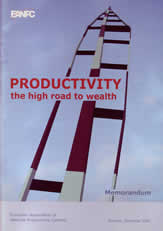

|
|
 |
1.1 The challenge of the 21st Century At the beginning of the 21st Century, all countries are confronted with a constantly changing set of challenges. These, to name the most significant, are:
Moreover there have been several important and relevant changes within Europe especially the introduction of the Euro, the Lisbon agenda, the debate about the social agenda, new member states in the European Union and last but not least the renewed interest in productivity and innovation due to the economic recession on the one hand and an aging workforce at the other. Of course it has to be recognised that the manifestations of these challenges and developments are different in different countries. Thus enterprises and organisations—public as well as private, those producing services as well as goods—need to harness all the resources available to them in the design and continuous re-design of organisations which seek—within the parameters of the ‘European model’—a continuously changing balance between all types of flexibility and security, in the interests of both the organisation and the individual. Only through the development of partnerships and co-operative approaches to these ends will it be possible to smoothly re-balance work and organisation for the benefit of all stakeholders. However in order to understand the practical consequences of more productivity for different stakeholders it has to be noted that productivity affects different levels of an economy: the macro level, (the level of a nation), the meso level (the level of a branch) and the micro level (the level of an individual producer or worker). It is important to realise that an act or a policy may have beneficial effects on stakeholders on the macro level while the same act or policy has detrimental effects on stakeholders on the micro level. Moreover productivity effects may have different consequences for different groups in society. Policymakers should not be looking only at the immediate consequences of an act or proposal, nor looking at the consequences only on a particular group to the neglect of other groups. It is true of course that the opposite error is possible. In considering a policy one ought not to concentrate only on its long-run results for the community as a whole. This is an error often made by the classical economists. It results in a certain callousness toward the fate of groups that were immediately hurt by policies or developments which proved to be beneficial on net balance (on the macro level) and in the long run. The most frequent fallacy today, however, is to concentrate solely on the short-run effects of policies on special groups and to ignore or belittle the long-run effects on the community as a whole. Suppose Joe Smith, a worker in a coat factory is thrown out of a job by the introduction of a new machine that boosts the productivity of a coat producer. This productivity measure has negative effects on Joe Smith, since he loses his job, but one must not forget that Tom Jones just got a new job in making the new machine, and Ted Brown, who has just got a job operating one and Daisy Miller who can now buy a coat for half what it used to cost her or John Jackson who got a new job at the grocery store because many Daisy Millers are able to buy cheaper food etc. Yes, policy makers should at least keep one eye on Joe Smith. He has been thrown out of a job by a new machine; perhaps he can soon get another job, maybe even a better one. But perhaps, also, he has devoted many years of his life to acquiring and improving a special skill, for which the market no longer has any use. He has lost his investment in himself, in his old skill, just as his former employer, perhaps has lost his investment in old machines or processes suddenly rendered obsolete. Policy makers must ask themselves what the policy implications are in the ‘Joe Smith cases’, which are numerous and often high profile when whole plants, or even firms, close down. Nowadays the issue of outsourcing work to low wages countries will typically
raise these problems for particular groups of people. The EANPC supports productivity
growth, since on the long-run and on net balance it is necessary for human
progress; but it proposes several directions toward policy measures that can
be taken to diminish the negative consequences of productivity growth for particular
groups or individuals in the short-run. In short: productivity growth will
enhance wealth and is therefore a good policy issue, but it has to be accompanied
by a policy to prevent unintended results. |
 |